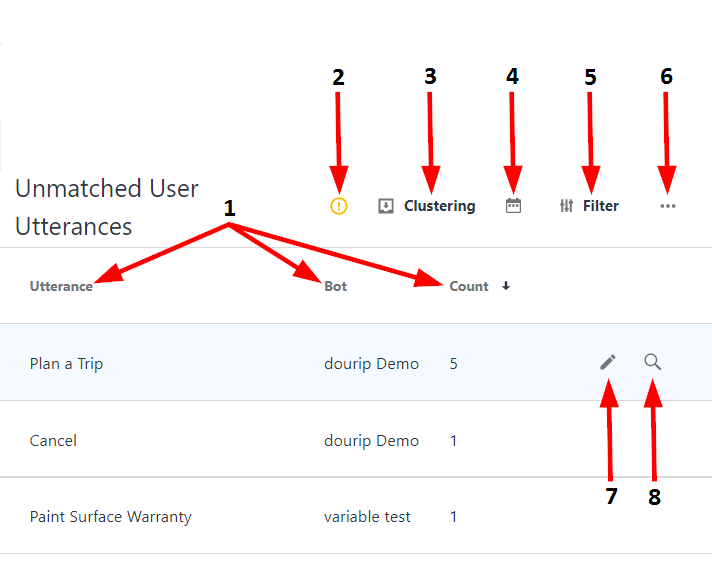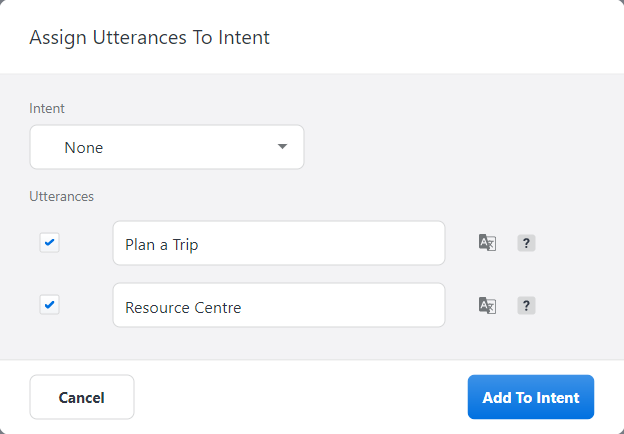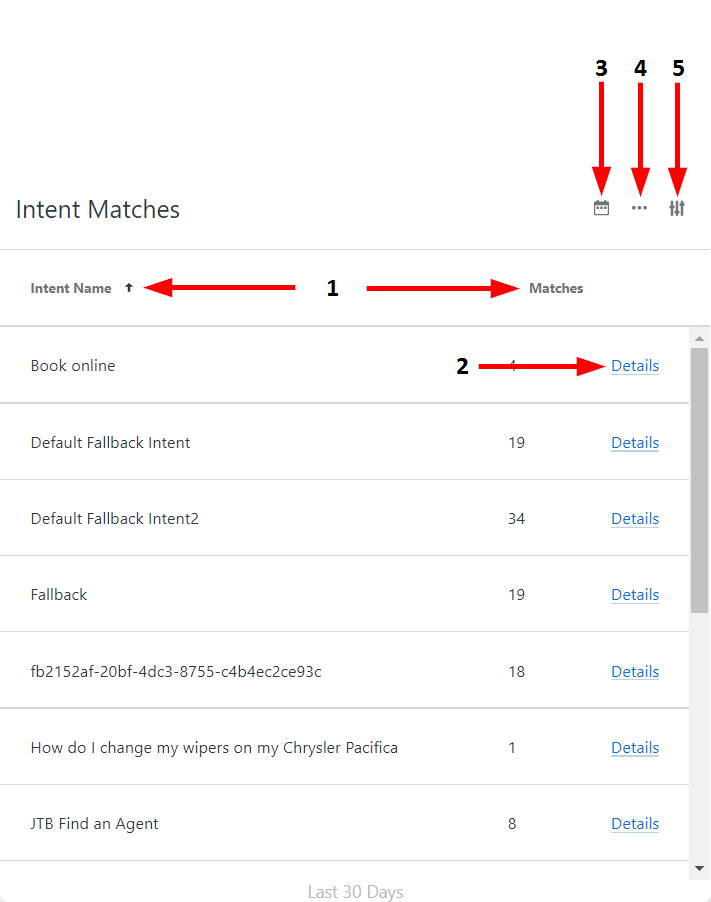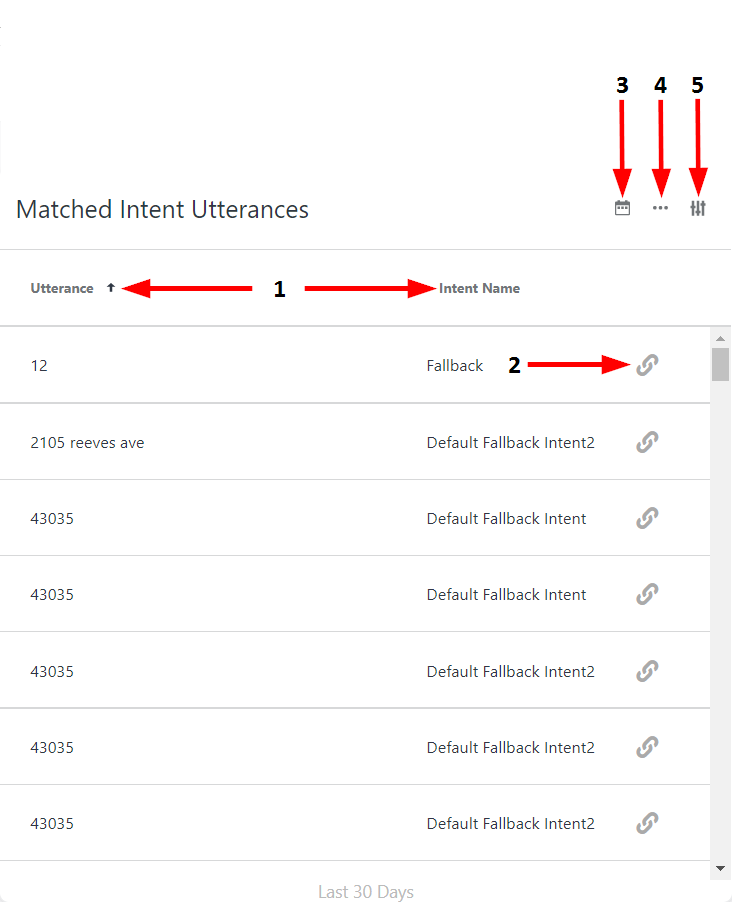Intents Analytics
The Intents Analytics page provides an overview of the performance of the intents being used across all of your bots. You can use this information to get a better idea of the questions that your users are asking, and what additional intents it may be helpful to author in your bots. For more information, see Intents.
Accessing the Intents analytics
From the Application Bar, click Analytics.
Click Intents.

Intents analytics page layout
The Intents Analytics page consists of two columns: Unmatched User Utterances and Intent Matches/Matched Intent Utterances. It also contains a Global Date Range button in the top right corner of the page.
Global date range button

Hover over the Intent Analytics banner to display the Global Date Range button.
Click here to set the date range for all reports on the Intent Analytics page.
If you select Custom from the drop-down menu, a calendar will appear for you to select a start date and an end date.
After you make your selections and click Apply, the reports will adjust to display data from this range.
Click Clear to reset the calendar.
Unmatched user utterances
This report contains a list of the messages sent by users that your bots were unable to identify and match to an intent, along with the number of times those utterances occurred. The system will group similar unmatched utterances together, so the count could either indicate that users are typing the same thing, or that they are typing similar things.
You can use this report to assign unmatched utterances to the appropriate intents. For more information, see the Assign Utterances To Intents section below.
Reviewing your unmatched utterances and matching them to proper intents should be done frequently to ensure that customer questions are being answered by your bots.
Buttons

Number | Name | Description |
|---|---|---|
1 | Sort By | Click the bold words at the top of a column to sort all the intent matches by the alphabetical or numerical order of that column's contents. The arrow that appears atop the selected column indicates whether the matches are sorted in ascending or descending order. |
2 | Notification Settings | Click here to configure notifications for when a high number of unmatched utterances are occurring in your bots. For more information, see the "Notification Settings" section below. |
3 | Clustering Settings | Click here to open a drop-down menu containing a slider tool, which you can use to adjust the clustering settings for unmatched user utterances. Moving the slider toward "Cluster Loosely" will permit utterances with lesser degrees of similarity to be grouped together, resulting in fewer and larger groups. Moving the slider toward "Cluster Tightly" will require utterances to have greater degrees of similarity in order to be grouped together, resulting in more and smaller groups. In the text field, you can type the maximum number of words that the intent will take into consideration when determining how to group an utterance. Your adjustments will save automatically. |
4 | Date Range | Click here to choose the date range of the report. If you select Custom from the drop-down menu, a calendar will appear for you to select a start date and an end date.
|
5 | Format | Click here to choose the format of the report. The report can be displayed as either a table or a word cloud. |
6 | Filters | Click here to filter the report's data by Platform, Channel, Bot, or Language. Select a filter, then choose an option from the corresponding list and click Apply (you can search through the options using the search bar at the bottom of the drop-down menu). The report will adjust to display only the filtered data. |
7 | Assign Utterances to Intent | Click here to open a dialog window where you can manually match an unmatched utterance with an intent. For more information, see the "Assign Utterances To Intent" section below. |
8 | View Grouped Utterances | Click here to open a window containing the grouped utterance associated with a corresponding entry in the report. In this window, click the Details button next to a grouped utterance to view the group's individual user utterances. For more information, see the "Grouped Utterance Details" section below. |
Assign Utterances to Intent

In the Unmatched User Utterances report, click the Assign button next to an unmatched utterance (#7 in the table above) to open the Assign Utterances To Intent window.
This window contains a list of the unmatched utterances in the selected group.
To assign them to an intent:
Select the utterances that you would like to match with an intent. You can select all of them or just a few by clicking the checkboxes next to each utterance.
Click the Intent drop-down to open a drop-down menu containing a list of available intents. Scroll to, or type in the name of, the desired intent.
After selecting an intent, click Add to Intent. The unmatched utterance will now be linked to the proper intent.
Notification settings

In the Unmatched Utterances Report, click the Alert button in the top right corner (#2 in the table above) to open the Notification Settings window.
This window allows you to configure how many unmatched user utterances within a certain time range are required to alert designated people in your company.
To configure these settings:
Type the desired number into the text field.
Use the drop-down menu to select the desired time range. The available options are:
15 minutes
One hour
One day
Use the slider tool to adjust how unmatched user utterances are clustered together.
Moving the slider toward "Cluster Loosely" will permit user utterances with lesser degrees of similarity to be grouped together, resulting in fewer and larger groups.
Moving the slider toward "Cluster Tightly" will require utterances to have greater degrees of similarity in order to be grouped together, resulting in more and smaller groups.
To designate recipients of the notification, click the Add button and choose a user from the pop-up list.
When you are finished, click Save.
Intent matches
This report appears on the left side of the Intent Analytics page by default. It contains a list of intent matches across all of your bots, along with the number of times they matched. You can delete this report and replace it with the Matched Intent Utterances report.
Buttons

Number | Name | Description |
|---|---|---|
1 | Sort By | Click the bold words at the top of a column to sort all the intents by the alphabetical or numerical order of that column's contents. The arrow that appears atop the selected column indicates whether the intents are sorted in ascending or descending order. |
2 | Intent Details | Click here to view the details of an intent. For more information, see the "Intent Details" section below. |
3 | Date Range | Click here to choose the date range of the report. If you select Custom from the drop-down menu, a calendar will appear for you to select a start date and an end date.
|
4 | Breakdown/Export | Click here to display a drop-down menu with two sections.
This section also contains the option to remove the report. To do so, click the Remove button. In the resulting empty column, click the Add button to display either the Intent Matches report or the Matched Intent Utterances report. |
5 | Filters | Click here to filter the report's data by Bot, Language, or Platform. Select a filter, then choose an option from the corresponding list and click Apply (you can search through the options using the search bar at the bottom of the drop-down menu). The report will adjust to display only the filtered data. |
Intent details

Click the Details button next to a specific intent to open the Intent Details window.
In this window, you can view how many matches the intent has had in a certain date range, what reactions it has received from users, and the groups of user utterances that have matched with it. Click X in the top right corner to return to the Intent Matches report.
Hovering over the Matches and Reactions sections displays three buttons:
Date Range
Organization
Filter
See above for details on using these buttons.
Grouped Utterance Details

In the Intents Details window, click the Details button next to a grouped utterance to view the group's individual user utterances which matched with the intent. To return to grouped utterances, click X in the top right corner of the Utterances section.
For each individual user utterance, there are three buttons you can click:
Edit Manual Match: Click here to manually match this utterance to another intent.
Conversation Context: Click here to display a drop-down window containing the utterance's context in its original conversation.
Conversation Permalink: Click here to go to the conversation in which the utterance was matched to the intent. For more information, see Conversations.
Matched intent utterances
This report contains a list of the things typed by users that your bots were able to identify and match to an intent, along with the intent that each utterance was matched to. You can delete this report and replace it with the Intent Matches report.
Buttons

Number | Name | Description |
|---|---|---|
1 | Sort By | Click the bold words at the top of a column to sort all the intent matches by the alphabetical or numerical order of that column's contents. The arrow that appears atop the selected column indicates whether the matches are sorted in ascending or descending order. |
2 | Conversation Permalink | Click here to go to the conversation in which the user utterance was matched to an intent. For more information, see Conversations. |
3 | Date Range | Click here to choose the date range of the report. If you select Custom from the drop-down menu, a calendar will appear for you to select a start date and an end date.
|
4 | Breakdown/Export | Click here to display a drop-down menu with two sections.
This section also contains the option to remove the report. To do so, click the Remove button. In the resulting empty column, click the Add button to display either the Intent Matches report or the Matched Intent Utterances report. |
5 | Filters | Click here to filter the report's data by Bot, Language, or Platform. Select a filter, then choose an option from the corresponding list and click Apply (you can search through the options using the search bar at the bottom of the drop-down menu). The report will adjust to display only the filtered data. |
